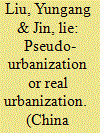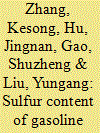|
|
|
Sort Order |
|
|
|
Items / Page
|
|
|
|
|
|
|
| Srl | Item |
| 1 |
ID:
172813


|
|
|
|
|
| Summary/Abstract |
This paper reviews the genealogy of ‘Chinese’ political geography, which, to a certain extent, can be read as a national report of the status of political geography in Chinese scholarship. It begins by outlining the short duration of the development of political geography in China, compared to the longer history of western political geography. Looking at the extant studies related to political geography in China, this paper suggests an existence of a duality in this field. One strand of scholarship is termed ‘exogenous political geography’, which is largely influenced by western scholarship with a particular focus on theories and vocabularies from classical geopolitics and geo-economy. The other strand is termed as ‘endogenous political geography’, which covers rich topics, including, yet not limited to, political and geographical views of inter-state relationships, central-local relationships and emperor-people relationships. Such a duality is important for understanding the condition of current political geography in China. The dualised understanding, however, seems to have undermined the comprehensiveness of political geography in China. In this regard, this paper calls for a more complete, integrated and critical agenda for political geography in China.
|
|
|
|
|
|
|
|
|
|
|
|
|
|
|
|
| 2 |
ID:
129092


|
|
|
|
|
| Publication |
2014.
|
| Summary/Abstract |
After the market reforms and opening tip ol" China in the late l97l)s. local governments played a central role in the country's rapid urbanization. particularly through the mergenee of administrative regions (MAR).
However. the effect of these MARs is still debatable. ()n the one hand. an MAR can accelerate the pace of economic growth. reshape the power structure. and establish necessary coordination among different regions. On the other hand. a MAR can have negative effects which have led to "pseudo-urbanization" in other developing countries. What is the effect of the local. state-led MAR in China'? This study examines the MAR implemented by the local government of Zhongshan city. Guangdong province. The MAR is found to be associated with the robust growth of the downtown area and of the urban population: it has gradually reshaped the socioeconomic structure of the city. the urban landscape. and the identity of its residents. MARs in China are argu- ably characterizcd b_v a transition from pseudo-urbanization to "real" urbanization. This transition cannot be explained by existing, urban theories. such as the "growth machine." "urban regime," or "entrepreneurial city." Therefore. we use the term "government-led merging urbanization" tGMLz) to define the process. We further suggest that the GML7 concept can be used as a model of urbanization or urban growth. This model provides an important perspective for examining the role played by local governments in the process of urbanization.
|
|
|
|
|
|
|
|
|
|
|
|
|
|
|
|
| 3 |
ID:
096126


|
|
|
|
|
| Publication |
2010.
|
| Summary/Abstract |
In order to investigate vehicle fuel quality in northern China, the sulfur content of fuels purchased from the market has been studied. 235 samples from urban areas and highway service stations were collected and tested with energy dispersive X-ray fluorescence spectrometry. 88% of the gasoline samples contained sulfur below 500 ppm, the limit then in effect, and 92.5% of the diesel fuel samples were below 2000 ppm, the required limit. China's Ministry of Environmental Protection recommend lower sulfur to assure that the vehicles using the fuels comply with the China III emission standards-those limits are 150 ppm sulfur for gasoline and 350 ppm for diesel fuel. The recommended limits were not often met: in Jinan, Shanghai, Changchun and Xi'an, 0%, 11%, 46% and 60% of the gasoline sampled were below 150 ppm sulfur. For samples from highway stations, only 14-58% of gasoline was under the 150 ppm sulfur and only 0-67% of diesel samples below 350 ppm in different regions. This mismatch, between fuel sulfur levels that would enable vehicle emission controls to operate effectively, and the actual fuel sulfur levels at service stations, results in unnecessarily high pollution from potentially cleaner vehicles.
|
|
|
|
|
|
|
|
|
|
|
|
|
|
|
|
|
|
|
|
|